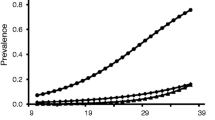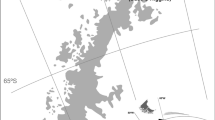Summary
1)The transmission dynamics of the protozoan parasite Sarcocystis carnae (Černá and Loučková 1976) (Apicomplexa, Eimeroidea, Sarcocystidae) in natural populations were studied in the Lauwersmeerpolder in the northern Netherlands. This parasite needs two hosts to complete its life cycle; the common vole (Microtus arvalis) as its intermediate host and the kestrel (Falco tinnunculus) which preys on the vole, as its final host. 2) Seasonal variation in prevalence of infection in snap-trapped common voles was determined in two years, 1984 and 1985. It was found to be lowest in November (6% of the voles infected) and it increased gradually to a peak in May (33%). 3) Data collected in three successive kestrel breeding seasons (1983–85) revealed that voles in the kestrel summer diet are infected twice as frequently as those in snap-trap samples, 21% and 9% respectively. This difference (P<0.05, X2-test) suggests that the parasite influences its intermediate host behaviour in such a way that it enhances the probability of parasite transmission to the final host.
Similar content being viewed by others
References
Bethel WM, Holmes JC (1973) Altered evasive behavior and responses to light in amphipods harboring acanthocephalan cystacanths. J Par 59:945–956
Bethel WM, Holmes JC (1977) Increased vulnerability of amphipods to predation owing to altered behaviour induced by larval acanthocephalans. Can J Zool 55:110–116
Brown AF, Thompson DBA (1986) Parasite manipulation of host behaviour: acanthocephalans and shrimps in the laboratory. J Biol Educ 20:121–127
Camp JW, Huizinge HW (1979) Altered color behavior and predation susceptibility of the isopod Asellus intermedius infected with Acanthocephalus dirus. J Par 65:667–669
Carney WP (1969) Behavioral and morphological changes in carpenter ants harboring dicrocoeliid metacercariae. Am Midl Nat 82:605–611
Cavé AJ (1968) The breeding of the kestrel (Falco tinnunculus L.) in the reclaimed area Oostelijk Flevoland. Neth J Zool 18:313–407
Černá Z, Loučková M (1976) Microtus arvalis as the intermediate host of a coccidian from the kestrel (Falco tinnunculus). Folia Par 23:110
Crowden AE, Broom DM (1980) Effects of the eyefluke Diplostomum spathaceum on the behaviour of the dace (Leuciscus leuciscus). Anim Beh 28:287–294
Daan S, Slopsema S (1978) Short-term rhythms in foraging behaviour of the common vole Microtus arvalis. J Comp Physiol 127:215–227
Holmes JC, Bethel WM (1972) Modification of intermediate host behavior by parasites. In: Canning EV, Wright CA (eds) Behavioral aspects of parasite transmission. Academic Press, New York, USA, pp 123–149
Hoogenboom I, Daan S, Dallinga JH, Schoenmakers M (1984) Seasonal change in the daily timing of behaviour of the common vole Microtus arvalis. Oecologia (Berlin) 61:18–31
Levine ND, Tadros WD (1980) Named species and hosts of Sarcocystis (Protozoa; Apicomplexa; Sarcocystidae). Syst Par 2:4–59
Long PL (1982) The biology of the coccidia. Edward Arnold Ltd
Mackin-Rogalskie R (1979) Elements of the spatial organisation of a common vole population. Acta Theriologica 24:171–199
Masman D (1986a) The annual cycle of the kestrel Falco tinnunculus; a study in behavioural energetics. Ph D thesis, State University of Groningen, p 227
Masman D, Gordijn M, Daan S, Dijkstra C (1986b) Ecological energetics of the European Kestrel: field estimates of energy intake throughout the year. Ardea 74:24–40
Moore J (1983) Altered behavior in cockroaches (Periplaneta americana) infected with an Archiacanthocephalan Moniliformis moniliformis. J Par 69:1174–1176
Moore J (1984a) Altered behavioural responses in intermediate hosts- an acanthocephalan parasite strategy. Am Nat 123:572–577
Moore J (1984b) Parasites that change the behaviour of their host. Sci Am 82:82–89
Raptor-Group RUG/RIJP (1982) Timing of vole hunting in aerial predators. Mammal Rev 12:169–181
Reichstein H (1964) Untersuchungen zum Körperwachstum und zum Reproduktionspotential der Feldmaus Microtus arvalis (Pallas 1779). Z Wiss Zool 170:112–222
Rijnsdorp AD, Daan S, Dijkstra C (1981) Hunting in the kestrel Falco tinnunculus and the adaptive significance of daily habits. Oecologia (Berlin) 50:391–406
Tadros WD, Laarman JJ (1976) Sarcocystis and related coccidian parasites: a brief general review together with a discussion on some biological aspects of their life cycles and a new proposal for their classification. Acta Leidensia volume XLV 44:1–137
Tadros WD, Laarman JJ (1982) Current concepts on the Biology Evolution and Taxonomy of tissue cyst-forming Eimeriid Coccidia. Adv Par 20:294–469
Wickler W (1968) Mimicry in plants and animals. New York: McGraw-Hill
Author information
Authors and Affiliations
Rights and permissions
About this article
Cite this article
Hoogenboom, I., Dijkstra, C. Sarcocystis cernae: A parasite increasing the risk of predation of its intermediate host, Microtus arvalis . Oecologia 74, 86–92 (1987). https://doi.org/10.1007/BF00377350
Received:
Issue Date:
DOI: https://doi.org/10.1007/BF00377350




